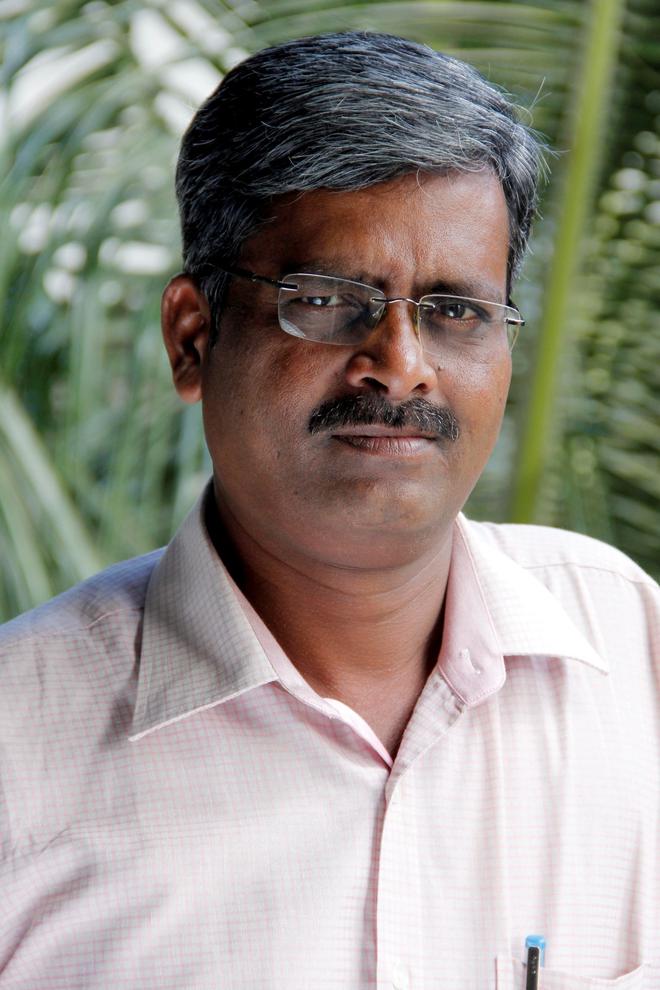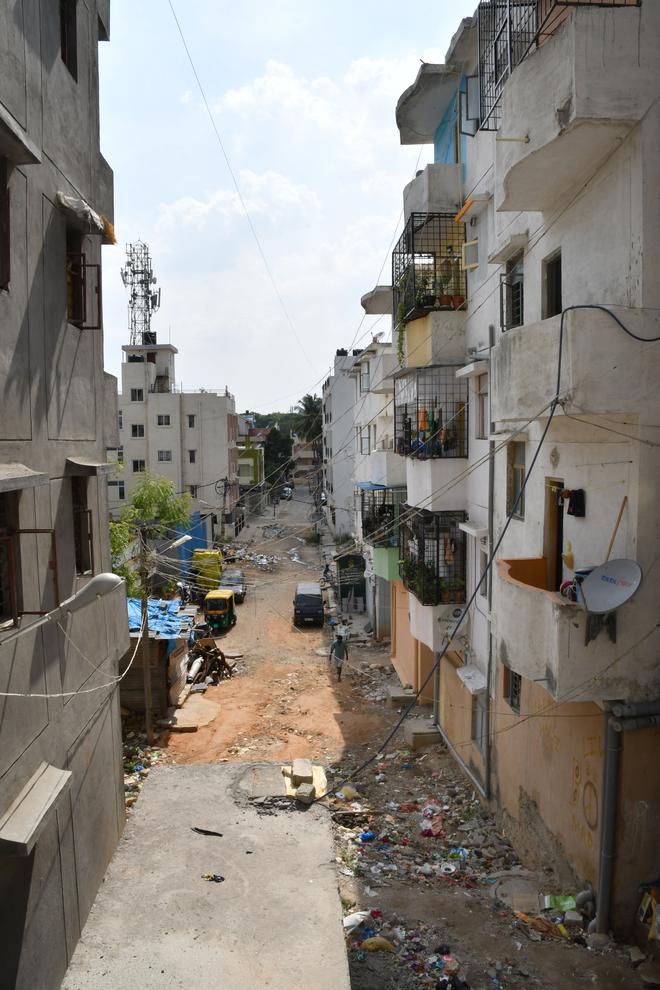Before 1982, a slum inhabited by 64 families occupied the space where the M.S. Building now stands in the heart of Bengaluru. In that year, the slum was relocated to government land in Laggere village. The residents were primarily from North Karnataka and predominantly worked as masons in the city.
Shambanna, a local resident, recalled that back then he attended the school located inside the premises of the Governor’s House that was close by. However, after they were relocated, they had to walk to Mahalakshmi Layout to catch a bus to school. “Soon after we moved, there was a bus strike, leaving my younger brother and me stranded without a means to return home. This incident frightened our parents, and they didn’t allow us to continue attending school. That’s why I work as a mason today,” he said.
No roads
Back then, the area they were relocated to had no accessible roads leading out of the slum. “Whenever we needed to buy something, we had to walk one and a half kilometres to Laggere Village. To catch a bus, we had to walk to Peenya or Mahalakshmi Layout, both far from our area. The Ring Road was constructed only in the year 2000. Despite subsequent developments, we still have to reach the main road to find autos or buses. There are no roads allowing ambulances to access our area,” bemoaned Shambanna.
The slum adjacent to Poornima Theatre was also relocated to Laggere in 1986. People from the community, however, still maintain a strong connection to the old neighbourhood. Every day, many of them commute from Laggere to Poornima Theatre for work. Women arrive in tempo vehicles to work in houses, offices, and marriage halls near Poornima Theatre, returning to Laggere in the same vehicles at the end of the day.

In yet another instance, the Railway Department demolished three slums near Padarayanapura Railway Track in 2002. Following prolonged efforts, the affected people were allocated plots measuring 15x20 in Singapura. According to Syed Afsar, a 50-year-old local leader, the residents struggled to find employment opportunities in the new neighbourhood. There are only two buses to the market from their area — one at 7 a.m. and another at 9 a.m. Missing these buses means missing out on a day’s wage as reaching after 11 a.m. makes it challenging to secure work. The last bus returning from City Market departs at 7.30 p.m., and one would need to spend the night on the streets upon failing to catch it.
Medical emergencies
Consequently, more than half of those who received plots from the Slum Board reverted to their rental homes. The area lacks a Government Hospital or specialised medical facilities for emergencies. In case of a medical emergency, individuals have to travel approximately 11 kilometres to K.C. General Hospital in Malleshwaram. There have been no instances of calling for an ambulance during emergencies. Instead, residents rely on available auto-rickshaws to reach hospitals.
Jyoti, a resident of the area, said, “During my delivery, I struggled to find transportation and ended up going to Bowring Hospital in an auto, which cost us ₹500. However, upon reaching the hospital, I was informed that the delivery couldn’t be conducted there. I had to be transferred to Vani Vilas Hospital in an ambulance. The only hospital near Sadaramangala is K.R. Puram Hospital, but there’s uncertainty about the availability of doctors at the time one visits.” Another resident recalled an incident where a woman gave birth in an auto while commuting from the area.
Why slums are relocated
In city slums houses are closely situated. Providing basic amenities in these areas is challenging due to inadequate infrastructure. The houses lack structural strength, and often, the land they occupy is either required by the government for various purposes or belongs to private entities that need clearance. Due to several such reasons residents of city slums are often relocated to the outskirts.
However, in the relocated slums, there’s a notable absence of space for children to play, parks for leisurely walks, libraries for reading, or safe areas for young adults to socialise. The parks within residential layouts have been handed over to resident welfare groups, who conveniently lock the gates, assign guards, and establish an unspoken rule that the park is exclusively for their use. Consequently, the residents of these slums are unable to access parks and playgrounds in nearby areas. It appears that city planners perceive these places merely as housing for city workers and as spaces to generate more labour.

Systemic exclusion
This kind of systemic exclusion from development opportunities highlights the deliberate disconnection imposed upon these communities. Although the relocation of slums is often touted as a means to uplift their residents from their impoverished conditions, the reality shows no tangible improvements in their lives. This calls into question the very idea of ‘rehabilitation.’
During the establishment of Koramangala slum, the government concurrently developed Koramangala Layout and Koramangala Industrial Area. Similarly, when 59 acres were allocated to the Laggere Slum Board for rehabilitation, the Peenya Industrial Area was expanding on one side, while Mahalakshmi Layout and Nandini Layout were being developed on the other. Even before slums emerged in Sadaramangala and Kudlu areas, the IT Corridor project along Sarjapur Road was already operational, encompassing these regions within its scope. A recurring pattern emerges where slums are relocated to such areas, leaving residents to grapple with hazardous conditions before development initiatives commence.
Notably, transportation infrastructure is often lacking, which potentially serves as a deliberate strategy by the government to confine these communities. The city consistently distances itself from these spaces by relocating them to the outskirts, devoid of essential healthcare infrastructure. This reveals an absence of humane considerations towards these communities.
From Dalit communities
It is striking to note that the majority of the individuals belong to Dalit communities, followed by other minorities.
Working in the city’s slums over the years, I am left asking what the city has built for those who have built the city. Among the numerous individuals we’ve spoken to from 20 different slums, not one mentioned using an ambulance. Government buses have never ventured into their areas, and it seems unlikely they ever will.
While the government’s initiative to allow free bus rides for women is commendable, there’s a need to introduce mini-buses that can navigate the narrow roads of these slums, offering affordable fares that consider the income levels of these residents. Although the Metro services are widespread in Bengaluru with connector buses between stations, they do not extend their services into these areas. Additionally, labourers are not allowed to carry their work tools inside the metro, thereby making this mode of transportation inaccessible to the poor.
There is a need for collective contemplation among the city’s residents on how to make such services accessible to everyone. Efforts should be made to legalise and establish a proper operational structure for shared autos and other convenient transportation methods that the people have established for themselves. Government intervention is crucial in providing free bicycles to high school children in slums as a priority. Access to parks and playgrounds should be ensured for everyone.
A telling incident from Bengaluru is when a businessman highlighted traffic congestion on the road to his company. He announced that he was considering relocating to another state or country due to the inconvenience caused. The government promptly responded by constructing a flyover on Hosur Road, starting from Madiwala. Building an inclusive Bengaluru means addressing the needs and challenges of citizens, including those who are often pushed to the margins.
The author is an activist and editor of ‘Slum Jagatthu’.’







